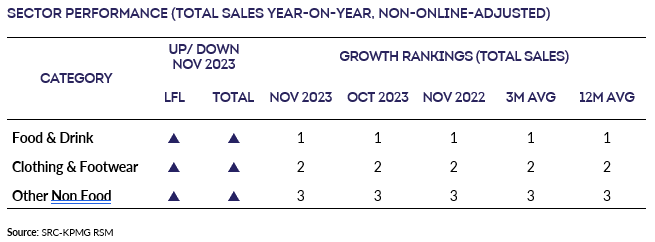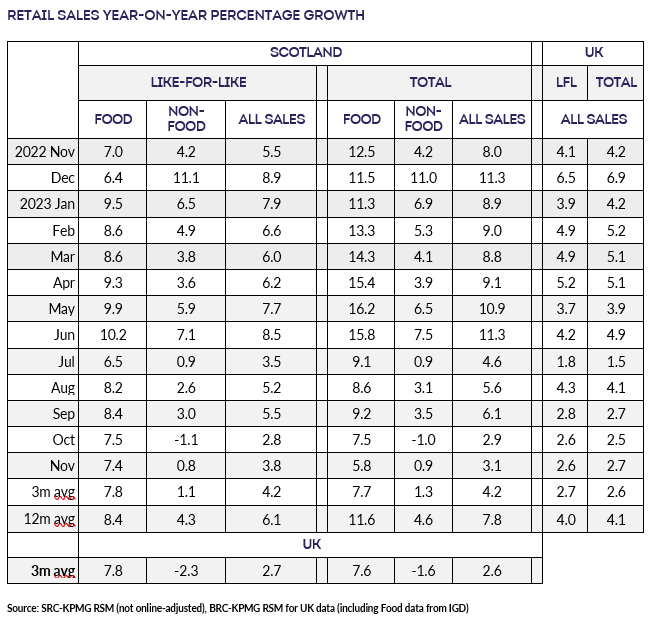Sales figures are not adjusted for inflation. Given that both the
November SPI (BRC) and October CPI (ONS) show inflation running
at above normal levels, a portion of the sales growth will be a
reflection of rising prices rather than increased volumes.
Covering the four weeks 29 October – 25 November
2023
- Total sales in Scotland increased by 3.1% compared with
November 2022, when they had grown 8.0%. This was below the
3-month average increase of 4.2% and below the 12-month average
growth of 7.8%. Adjusted for inflation, the year-on-year decline
was 1.2%.
- Scottish sales increased by 3.8% on a Like-for-like basis
compared with November 2022, when they had increased by 5.5%.
This is below the 3-month average increase of 4.2% and the
12-month average growth of 6.1%.
- Total Food sales increased by 5.8% versus November 2022, when
they had increased by 12.5%. November was below the 3-month
average growth of 7.7% and the 12-month average growth of 11.6%.
The 3-month average was below the UK level of 7.6%.
- Total Non-Food sales increased by 0.9% in November compared
with November 2022, when they had increased by 4.2%. This was
below the 3-month average increase of 1.3% and the 12-month
average of 4.6%.
- Adjusted for the estimated effect of Online sales, Total
Non-Food sales decreased by 0.2% in November versus November
2022, when they had increased by 4.0%. This is below the 3-month
average growth of 0.1% and the 12-month average of 3.3%.
Ewan MacDonald-Russell, Deputy Head | Scottish Retail Consortium
"Black Friday sales were a damp squib for Scotland’s retailers as
sales fell in real terms in November. Adjusted for inflation
retail sales fell by 1.2 percent, the fifth successive month of
declining performance; including the first two months of the
‘golden trading quarter’.
“Food sales rose by 5.8 percent, but this was below the
3-month-average as reduced levels of inflation start to feed
through to consumers. Cosmetics and fragrances performed
reasonably well because of early discounting, with perennial
favourite beauty advent calendars proving popular. Shoppers
continue to shy away from larger purchases, and it appears many
are holding back festive gift spending, either hoping for further
discounts ahead of Christmas itself or just cutting back in the
face of the continued cost of living squeeze. If retailers oblige
with discounts, that will further eat into already narrow margins
in what is traditionally the most profitable trading period.
“These figures are concerning for hard-pressed retailers many of
whom desperately need a good last quarter of 2023 to get them
through the traditionally fallow months at the start of next
year. Retailers already know they will be facing large increases
in wage costs in the new year. If the Scottish Government
doesn’t take action in it’s upcoming Budget to meaningfully blunt
a rise in business rates then shops will very likely have to make
very difficult decisions in 2024 to balance the books.”
, Partner, UK Head of
Retail | KPMG
“As Christmas approaches, sales growth in November remained
lacklustre at 3.1% across Scotland, despite retailers making a
significant push with Black Friday deals.
“The growth drivers persist in categories like food and drink,
health, as well as personal care and beauty. This trend indicates
a shift in consumer preferences towards more budget-friendly
gifts, likely as a response to the cost-of-living crisis
affecting many households. In the final month of the year,
economic conditions continue to test consumer resilience, and
with sales growth struggling, the emphasis on price as the
primary purchasing driver is evident. We are likely to see a
prolonged and strategically targeted period of discounting as
retailers vie for a diminishing pool of consumer spending and aim
to clear their stock.
“The critical golden quarter in Scotland has already experienced
two months with sales growth below 3%, making it a weak Christmas
trading period. The prospect of excess stock remaining unsold
before Christmas raises the possibility of substantial January
sales, potentially exerting even more pressure on already tight
profit margins. Looking ahead to the early months of 2024, the
challenges are expected to persist, posing a threat to the sector
and potentially leading to more casualties, especially for online
retailers facing over 28 consecutive months of sales decline.”



